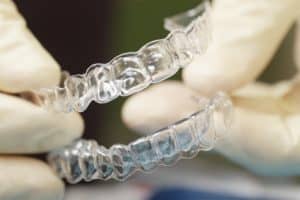Braces (Orthodontics)
Braces are an orthodontic appliance placed in your mouth to correct crooked teeth or a misaligned bite, such as an overbite, underbite, and or crossbite. Braces generally include bands, wires, brackets, and other components that work together to apply continuous pressure to realign your teeth to be straight and evenly spaced. They may be used in conjunction with a retainer or exterior headgear.
Your orthodontist will determine what kind of approach is required to best treat the severity of your bite misalignment, taking into consideration age— usually between age 14 to adulthood— and the health of the teeth. Some teeth may require dental or gum work prior to adding braces or newer appliances, but Allo Dental will create the best treatment plan to get you there!
Who Needs Braces?
The best time for a first visit to the orthodontist is around age 7, but patients can get braces at any age. You might need braces if:
Braces Costs
Indicative US rate: $129/mo. – Starts at from $69/mo. at Allo Dental
Schedule Your Free Consultation
Please select a valid formTypes of Braces & Cost
There are many different kinds of braces that your orthodontist will consider for treating you.
| Types og Braces | Cost |
|---|---|
| Conventional metal brackets | $60 |
| Conventional aesthetic brackets * Sapphire | $80 |
| Brackets self-ligating metal * Damon Q | $100 |
| Self-ligating brackets * Damon Clear | $100 |
| Invisalign full | $300 |
* Prices do not includes downpayment.
Most people are familiar with traditional metal braces that are fitted across your teeth. These are generally the least expensive option, but also the most visible.
Less visible braces include ceramic braces and lingual braces. Ceramic braces are like metal braces, except their brackets and sometimes the wires are tooth-colored for a more natural look. Lingual braces are metal, but are placed on the inside of the teeth where they are less visible. Both options cost more and can be more difficult to clean than traditional braces.
Your final option may be Invisalign. These clear plastic aligners are removable, easy to clean, and almost invisible. However, they are the most expensive alignment option and are not effective for severe dental problems. They also do not correct skeletal issues.
Why are braces used?
Braces are used for different purposes, including preventative orthodontics, interceptive orthodontics, corrective orthodontics, or functional orthopedics.
What can you expect at your first appointment?
At your first appointment, you will have to go through what is known as a detailed orthodontic study to determine a diagnosis and the treatment plan. It consists of:
- Intra/extra oral photos for our records and yours.
- Study models and assembly in the articulator to simulate your bite (occlusion)
- Radiographs such as panoramic, lateral, and anterior which have to be taken every so often so that we can show how your have progressed.
- Cephalometric analysis (these are measurements that allow the orthodontics create your special treatment plan)
With all this information, the orthodontist will assess the objectives to be achieved and determine the type of orthodontics are most appropriate to your case.
Remember that in order for you to qualify for orthodontic treatment you must be free of decay and at max health.
Putting on your braces is an easy orthodontic procedure, but you should be aware of a few things for later.
For instance, your teeth and mouth will be sore for about a week afterward as they get used to the constant pressure of the braces. You will want to limit yourself to soft foods for the first few days and take over-the-counter pain relief as needed.
It is common to develop sores where your new braces rub inside your mouth, or if you’re biting your cheek or using your mouth differently as you get used to the braces. Orthodontic wax can be applied to your braces where they’re creating friction, and an over-the-counter oral anesthetic can numb sores while they heal.
Most patients grow accustomed to their braces within a month, but if the pain ever starts again use the methods above to find relief.
Will There be Discomfort in Getting Braces?
The brackets do not produce pain when they are placed on teeth nor in the different adjustments that the specialist will perform throughout the treatment. However, there is a feeling of pressure on the teeth, and this will be the same every month and each time you adjust them. The discomfort will subside in two or three days with the option of taking some low-grade ibuprofen.

Benefits of Braces
There are many benefits to getting braces, for your oral health as well as your self-confidence. Below are just some of the many positive changes you may see:
Misaligned teeth or jaw bones make chewing food difficult. Fixing this misalignment with braces aids digestion, prevents jaw fatigue, and prevents the exaggerated wear and tear of teeth. Tooth crowding can also lead to the inability to maintain proper hygiene which causes tooth decay and gingival diseases.
Correcting the alignment of your jaw and teeth can improve the proportions of your face and mouth and straighten your smile, which most of us find more attractive. It’ll also provide relief to the supporting tissues like bone and gums, which are otherwise under constant duress. Lack of correction may lead to migraines, speech problems, nutrition and gastrointestinal issues, breathing problems, self-esteem issues, and facial neck pain.
Common Braces Questions
Get Treatment Estimate
Before stepping foot in our dental office, we provide you with a preliminary treatment estimate.
It’s 100% free, and with no commitment.

